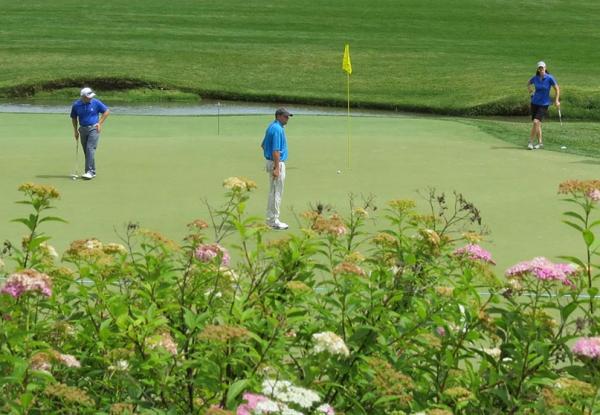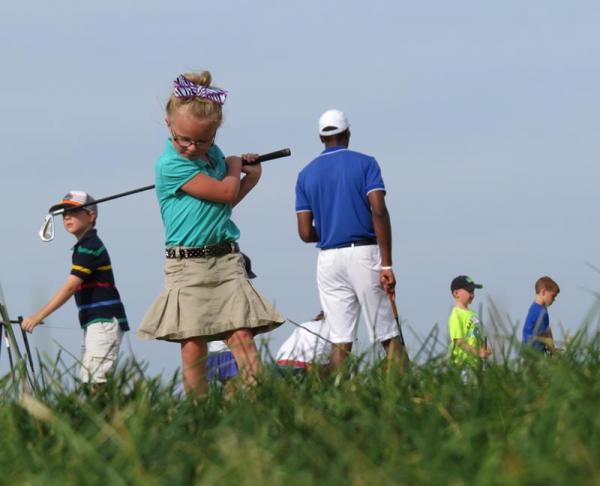Golf has a past built on tradition and history. But a break from yesteryear might be in the offing if the game is to have a future.
 That was the take-home message from this year's state of the industry report given each year at the PGA Merchandise Show by Jim Koppenhaver of Pellucid Corp. and Stuart Lindsay of Edgehill Golf Advisors, who have gained a reputation for delivering sobering news with a touch of humor but with little or no regard for the feelings of industry cheerleaders.
That was the take-home message from this year's state of the industry report given each year at the PGA Merchandise Show by Jim Koppenhaver of Pellucid Corp. and Stuart Lindsay of Edgehill Golf Advisors, who have gained a reputation for delivering sobering news with a touch of humor but with little or no regard for the feelings of industry cheerleaders.The long and short of the report revealed that while rounds played were up slightly in 2016, the number of golfers is down, courses continue to close faster than they open and golf-playing Baby Boomers are all that stand between an industry making a slow recovery and one that is flat-lining.
"We have to change perceptions of the game. We have to change the product," Koppenhaver said. "We have the traditionalist who says 'this is golf, you either like it or you don't.' I'm sorry, the people have voted out there, and a lot of people have voted they don't (like it).
"If it weren't for Baby Boomers right now we'd be in a world of hurt."
That's a sobering message for a game that clings to Old Tom Morris as fervently as it does Jordan Spieth.
Improving pace of play through course set-up and management, promoting the time-saving merits of match play, offering free lessons along with a friendly and welcoming environment are just a few things that could help stop the bleeding. But finding the key to what will work and what will not must be discovered on a course-by-course basis.
"Somebody has to wake up and ask if we are presenting ourselves in the right way," Koppenhaver said.
There was some good news coming out of the report that attracted about 300 golf-hardened realists both in person and online in two separate sessions.
Rounds played in 2016 were up nationwide by 1 percent from 458.1 million in 2015 to 462.6 million, marking the second consecutive year of marginal growth, but at least it's growth. That mark is well behind the all-time high of 518.4 million rounds played in 2000 and is way off the original Golf 2020 projections of 1 billion rounds by year 2020.
"Obviously, that's not going to happen," Koppenhaver said.
Golf is hard. Golf is a game of positive aspirations. But it's also a game of negative feedback."
Two years of a modest increase in play combined with courses closing at a rate of about 1 percent per year are bringing the industry closer to supply-demand equilibrium. Koppenhaver's Pellucid says golf facilities are healthiest when the average number of rounds per facility is about 35,000. Right now, that number is about 33,200. If Baby Boomers continue to prop up the game at the current pace for the next generation or so, equilibrium will occur sooner rather than later.
"At this rate, we will reach equilibrium in three to four years, not 10 years," he said.
A total of 22 courses (in 18-hole equivalents) opened in 2016, while 176 closed, marking the 11th straight year that closings have outpaced openings. Since that trend started in 2006, there has been a net loss of 1,148 18-hole equivalents (EHE).
Tracking the number of golfers in the game lags behind other industry markers by a year . . . which might be a good thing. The number of people playing the game is down, from 22 million in 2014 to 21 million in 2015. The zenith occurred in 2002 when 29.8 million people were in the game.
Since then, golfer attrition was attributed primarily to males as women and girls flocked to the game, but no more. Female players also dropped out of the game in 2015, and at a much higher rate than their male counterparts. Each showed a net loss of about a half-million players, but there are only 5.9 million female golfers compared with 15.1 million males who play the game.
Younger players also fled the game in 2015, with the 7-17 and 18-34 age groups accounting for nearly 700,000 of those losses.
Oversupply is not the biggest problem facing golf, Koppenhaver said. The problem is not enough golfers.
Koppenhaver said he thought by now that Baby Boomers would be the proverbial icing on the cake. Instead, they represent the flour, eggs and sugar in an otherwise icingless confection.
"Instead of them being a dividend, the Baby Boomers are basically supporting our industry right now," he said.
"Baby Boomers are playing more as they age. They are doing what we thought they would, but the under 30s are not doing what we did when we were under 30."
 Public courses are toting the water for the rest of the industry.
Public courses are toting the water for the rest of the industry. A total of 372.2 million rounds were played on daily fee courses in 2016, which are up from 367.9 million in 2015 and 359.3 million in 2014. That number is down from the 381.1 million rounds played on public-access facilities in 2012 and mirrors the 372.2 million rounds played in 2009.
The trend is much different at private clubs, where 88.4 million rounds played in 2016 are down from 88.6 million in 2015, and way down from the 100 million rounds played in 2012 and the 103.3 million in 2009.
Koppenhaver discounts the popular notion that rounds at private clubs are irrelevant because of upfront dues. But a 14-percent drop in play over seven years can't be ignored.
"(Private rounds) do matter," he said. "If they're not getting value from their membership, what do they do? They drop their membership. That decline means (private clubs) will go out of business."
There are a host of reasons why golf is struggling, Lindsay said. It's expensive and it takes a long time to play, neither of which appeals to younger generations, and it's hard to play, which is the death knell for millennials seeking immediate gratification.
"Golf is hard," Lindsay said. "Golf is a game of positive aspirations. But it's also a game of negative feedback."
These numbers have rocked the golf equipment world, where combined sales of clubs, balls, shoes and gloves are off by a total of 7 percent. That's the worst year-to-year performance, Koppenhaver said, since 2009 and was enough to send Nike scurrying out of the stick-and-ball business altogether last summer.
Right now, the $64,000 question is what happens in another 20 years when Baby Boomers no longer can carry the game on their shoulders.
Lindsay's answer was of little comfort.
"That's when all hell's going to break loose."
- Note: Part I in a series of business-development issues affecting the golf industry

